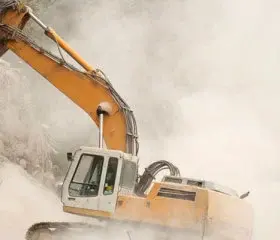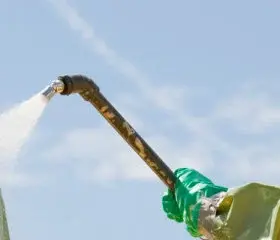/474442905-1600x400-1.jpg?width=300&name=474442905-1600x400-1.jpg)
EXCAVATION AND EARTHWORK COMPLIANCE
Excavations and earthworks present many unique and dangerous hazards. Follow these eight steps to minimise the hazards to your employees, the public, and the environment.
A Work Permit should be issued prior to the commencement of any excavation or trenching work.
Before issuing a work permit for any such works, consider all reasonably foreseeable hazards, along with the control methods.
The precautionary considerations should include these primary points:
- Consult the relevant up-to-date documentation and drawings. When required, the relevant authority or utility should be contacted to obtain the necessary information.
- Identify the location and depth of buried or hidden services. This should include gas, water, sewers, electricity, telecommunication and others.
- Isolate underground services that may be affected. If isolation is not practical (e.g. the main power supply to a site) protect underground services.
- Consider the possible structural impact on buildings or structures.
When an unforseen hazard is identified during an excavation process that is not covered in the Work Permit, work should cease immediately. This is imperative when such hazards have the potential for causing serious harm to personnel, environment or property.
Work should re-commence when the identified hazard has been suitably controlled.
The Work Permit process should cover authority levels for these matters.
To carry out excavation work, all persons involved should be qualified and trained for the task (e.g. operation of front-end loaders, excavating machines, etc.).
Such personnel should also hold the appropriate certificate of competency in accordance with the National Guides for Occupational Health and Safety Competency Standards for the Operation of Loads-shifting Equipment and Other Types of Specified Equipment.
Ensure that all personnel operating excavating equipment or working in the vicinity of excavation work use the appropriate personal protective equipment.
Risk control measures such as separation distance requirements should be implemented to minimise the danger from flying object hazards (e.g. rocks, gravel, sand). This is important as surrounding personnel or members of the public could be endangered.
It is crucial for a trained person to carry out an assessment of the stability of the excavation when operating earthmoving machinery adjacent to excavations. This should be done at appropriate intervals, taking into consideration the activities around the excavation and the type and weight of the mobile plant used.
In cases where trucks with tipper trays are used, arrangements should be made to ensure personnel are not present at the hazard zone (i.e. under a raised tipper tray). If it is necessary for personnel to be in the hazard zone for any reason such as maintenance or repair, the following precautions should be taken:
- The hydraulics should incorporate a safety back-up system ; and
- Adequate safety prop(s) should be in place.
As a precautionary measure, deep trenches should be surrounded by safety barriers to prevent personnel from falling in. Such barriers should be maintained in good condition, including the following arrangements:
- Webbing should be maintained in good condition to provide an effective barrier and visual warning;
- Star pickets should be numerous enough to ensure webbing is maintained in a rigid condition;
- Star pickets should not be placed at the immediate edge of the excavation;
- Star pickets should be fitted with protective caps to prevent injury as a result of inadvertent contact;
All components of the safety barrier should be regularly checked to ensure they are in a serviceable condition.
If work is planned or progressing for an extended period of time, a more permanent and substantial type of safety barrier/ fencing should be provided.
The risk management process should consider the potential of trench collapse and the control measures of shoring the trench.
Trenches should not be left unfilled overnight, unless this is unavoidable. In this event, warning signs and lights should be used for all open trenches.
Where electrical cables are laid in trenches, they should be protected (conduits, slabs, etc) and marked, in accordance with the relevant legislative and Australian Standards requirements.
The following should be carried out prior to commencement of excavation work or earthwork in or adjacent to bodies of water:
- Assessing the stability of the work surface
- Determining the depth of water along the expected work area and whether it may be affected by tidal flow, etc.
- Identifying unsafe areas
- Determining if it is possible to work from level areas, including temporary pads
- Preparing emergency procedures
- Selecting the most appropriate plant for the task and the site conditions and ensure all safety features and emergency exits are in working order
To minimise dust emissions, it is best to evaluate potential sources of dust. This may include the excavation process itself, the transfer point and the routes for trucks in order to determine the ways to reduce dust emissions.
This should include, as applicable:
- Water spray of road and transfer points
- Where possible, enclosure of transfer points
- Minimisation of exposed soil surfaces
- Utilisation of wind deflectors (e.g. away from housing, etc.)
Special precautions (e.g. respiratory protection) should be taken when excavating in locations where there may be a hazard of silica dust.
Be sure to monitor these implementations for their effectiveness. Subsequently, corrective action should be taken to rectify any identified deficiencies.
At the completion of the work, be sure to clear the work site of all rocks, soil and other debris and return it to its original condition as much as possible.
Drawings and other documentation should be updated to reflect any changes due to the work just completed, including a dated digital photograph.
Struggling to keep track of excavation risks and compliance tasks?
Simplify and streamline with Safety Nett—our smart, centralised solution designed to help you stay ahead of high-risk work requirements.
Download Your Free Checklist PDF
Get instant access to our expert-designed checklist to help you. Simply fill out the form below to download your copy.SIMILAR READINGS

2 min read
2 min read
Contractors and their skills are a valuable addition to the...
Read More

2 min read
2 min read
4 must-do steps to ensure you comply with legislation and...
Read More
2 min read
2 min read
Keep staff required to work in confined spaces safe with...
Read More
1 min read
1 min read
Want to maintain positive relations with the community? Try...
Read More